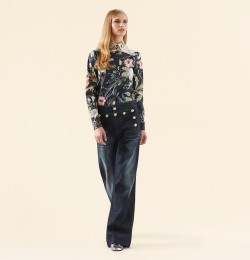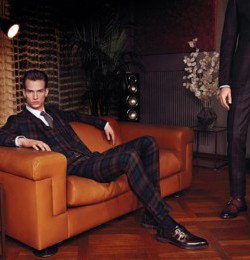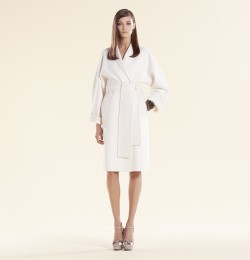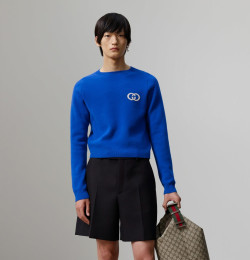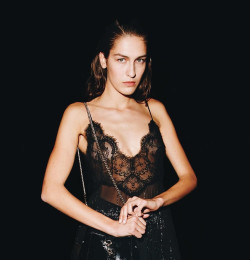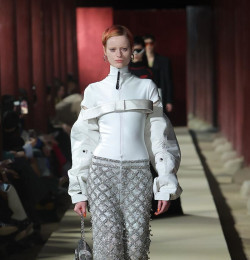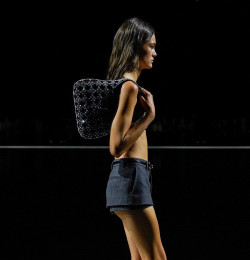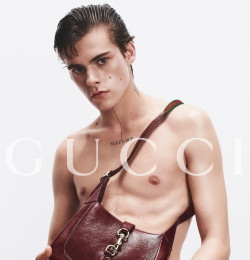

Gucci
Via Don Lorenzo Perosi, Cassellina Scandicci
Florence, 50018
Italy
About
founded by
Guccio Gucci
belongs to
Gucci Group
about
The House of Gucci, better known as simply Gucci, is an Italian iconic fashion and leather goods label. It was founded by Guccio Gucci (b.1881 - d.1953) in Florence in 1906. Gucci is considered one of the most famous, prestigious, and easily recognizable fashion brands in the world.
Gucci generated over US$7 billion worldwide of revenue in 2006 according to BusinessWeek magazine and was ranked 46th in the magazine's annual chart "Top 100 Brands". For this reason Gucci is the second biggest selling fashion brand after LVMH. Most importantly Gucci is the biggest selling Italian brand in the world. The House of Gucci belongs to the French conglomerate company Pinault-Printemps-Redoute (PPR). Gucci operates about 425 stores worldwide and it wholesales its products through franchisees and upscale department stores.
In 1921, Guccio Gucci opens a leather goods company and small luggage store in his native Florence. Having spent years working in London's Savoy Hotel, he had absorbed the refined aesthetic of English nobility, and introduces this sensibility in Italy through exclusive leather goods created and produced by the master craftsmanship of Tuscan artisans.
In 1938, Gucci expanded and a boutique was opened in Rome. Guccio was responsible for designing many of the company's most notable products.
In 1947, Gucci introduced the "Bamboo Bag", which become one of the first of Gucci's iconic products.
During the 1950s, the trademark green-red-green web, which is derived from the saddle girth, becomes a great success and remains one of the most familiar identifiers of the brand. With stores opening in Milan and New York, Gucci starts to build a global presence as a symbol of modern luxury.
Guccio Gucci dies in 1953. His sons Aldo, Vasco, Ugo and Rodolfo take over the business.
After Guccio's death, Aldo helped lead the company to a position of international prominence, opening the company�s first boutiques in London, Paris, Palm Beach and Beverly Hills. Even in Gucci�s fledgling years, the family was notorious for its ferocious infighting. Disputes regarding inheritances, stock holdings, and day-to-day operations of the stores often divided the family and led to alliances. Gucci expanded overseas, board meetings about the company�s future often ended with tempers flaring and luggage and purses flying. Gucci targeted the Far East for further expansion in the late 1960s, opening stores in Hong Kong, Tokyo, and Korea. At that time, the company adopts the legendary interlocking double 'G' logo, the Flora silk scarf (worn by Grace Kelly), and the Jackie O shoulder bag, made famous by Jackie Kennedy, the wife of U.S. President John F. Kennedy.
Gucci remained one of the premier luxury goods establishments in the world until the late 1970s, when a series of disastrous business decisions and family quarrels brought the company to the verge of bankruptcy. At the time, brothers Aldo and Rodolfo controlled equal 50% shares of the company, though contributed less to the company than he and his sons did. In 1979, Aldo developed the Gucci Accessories Collection, or GAC, intended to bolster the sales for the Gucci Parfums sector, which his sons controlled. GAC consisted of small accessories, such as cosmetic bags, lighters, and pens, which were priced at considerably lower points than the other items in the company�s accessories catalogue. Aldo relegated control of Parfums to his son Roberto in an effort to weaken Rodolfo�s control of the overall operations of the company.
Aldo Gucci expanded into new markets including an agreement with American Motors Corporation (AMC). The 1972 AMC Hornet compact "Sportabout" station wagon became one of the first American cars to offer a special luxury trim package created by a famous fashion designer.
Though the Gucci Accessories Collection was well received, it proved to be the force that brought the Gucci dynasty crashing down. Within a few years, the Parfums division began outselling the Accessories division. The newly-founded wholesaling business had brought the once-exclusive brand to over a thousand stores in the United States alone with the GAC line, deteriorating the brand�s standing with fashionable customers.
It did not take long before ravaged the company�s pomp by flooding the market with cheap knockoffs, further tarnishing the Gucci name. Meanwhile, infighting was taking its toll on the operations of the company back in Italy: Rodolfo and Aldo squabbled over the Parfums division, of which Rodolfo controlled a meager 20% stake. By the mid-1980s, when Aldo was convicted of tax evasion in the United States by the testimony of his own son, the outrageous headlines of gossip magazines generated as much publicity for Gucci as its designs.
Rodolfo�s death in 1983 caused a major shakeup in the company when he left his 50% stake in Gucci to his son, Maurizio Gucci. Maurizio allied with Aldo�s son Paolo to gain control of the Board of Directors and established the Gucci Licensing division in the Netherlands for purposes. Following the decision, the rest of the family left the company and, for the first time in years, one man was at the helm of Gucci. Maurizio sought to bury the fighting that had torn the company and his family apart and turned to talent outside of the company for Gucci�s future.
A turnaround of the company devised in the late 1980s made Gucci one of the world's most influential fashion houses and a highly profitable business operation. In October of 1995 Gucci went public and had its first initial public offering on the AEX and NYSE for $22 per share. November of 1997 also proved to be a successful year as Gucci acquired a watch licensee, Severin-Montres, and renamed it Gucci Timepieces. The Gucci brand is considered one of the most frequently mentioned brands in music. The firm was named "European Company of the Year 1998" by the European Business Press Federation for its economic and financial performance, strategic vision as well as management quality.
Gucci world offices and headquarters are in Milan, Paris, London, New York, Boston, San Francisco, Beverly Hills, Honolulu, Tokyo, and Shanghai.
In 1989, Maurizio managed to persuade Dawn Mello, whose revival of New York's Bergdorf Goodman in the 1970s made her a star in the retail business, to join the newly formed Gucci Group as creative director. At the helm of Gucci America was Domenico De Sole, a former lawyer who helped oversee Maurizio�s takeover of ten 1987 and 1989. The last addition to the creative team, which already included designers from Geoffrey Beene and Calvin Klein, was a young designer named Tom Ford. Dawn Mello hired Ford in 1990 at the urging of his partner, writer and editor Richard Buckley.
In the early 1990s, Gucci underwent what is now recognized as the poorest time in the company's history. Maurizio riled distributors, Investcorp shareholders, and executives at Gucci America by drastically reining in on the sales of the Gucci Accessories Collection, which in the United States alone generated $110 million in revenue every year. The company�s new accessories failed to pick up the slack, and for the next three years the company experienced heavy losses and teetered on the edge of bankruptcy. Maurizio was a charming man who passionately loved his family's business, but after four years most of the company's senior managers agreed that he was incapable of running the company. His management had had an adverse effect on the desirability of the brand, product quality, and distribution control. He was forced to sell his shares in the company to Investcorp in August of 1993. Dawn Mello returned to her job at Bergdorf Goodman less than a year after Maurizio�s departure, and the position of creative director went to Tom Ford, then just 32 years old. Ford had worked for years under the uninspiring direction of Maurizio and Mellow and wanted to take the company�s image in a new direction. De Sole, who had been elevated to CEO, realized that if Gucci was to become a profitable company, it would require a new image, and so he agreed to pursue Ford�s vision.
Domenico De Sole was incensed by the news and declined Arnault�s request for a spot on the board of directors, where he would have access to Gucci�s confidential earnings reports, strategy meetings, and design concepts. De Sole reacted by issuing new shares of stock in an effort to dilute the value of Arnault�s holdings. He also approached French holding company Pinault-Printemps-Redoute (PPR) about the possibility of forming a strategic alliance. Francois Pinault, the company�s founder, agreed to the idea and purchased 37 million shares in the company, or a 40% stake. Arnault�s share was diluted to a paltry 20%, and a legal battle ensued to challenge the legitimacy of the new Gucci-PPR partnership, with the law firm of Skadden, Arps, Slate, Meagher & Flom representing Gucci. Courts in the Netherlands ultimately upheld the PPR deal, as it did not violate that country's business laws. PPR now owns 68% of the group. The second largest shareholder is Cr�dit Lyonnais with 11%. As of September 2001 a settlement agreement was put into place between Gucci Group, LVMH, and PPR. 2001 was also an incredible year for the Gucci Group as it acquired percentages of Bottega Venetta, Di Modolo, Balenciaga, and formed a partnership with Stella McCartney.
In the 2004, the company, with its record high sales, went up for sale. The asking price was �7.2 Billion. Three very important people in the fashion industry decided to form three individual groups to take a dramatic impact on the fashion industry. They were Barry Dhillon, Pam Dhillon, and Rebecka John. Barry Dhillon was a highly respected person who was a catwalk specificationist and perfectionist in all of his directing and fashion roles he fulfilled with a team of 5,000 staff per team. Pam Dhillon with her organisation, and operation solo fire which put her high team of 10,000 staff to investigate further into other fashion teams and units, highly trained fashion surveillance. Rebecka John who worked closly with Barry and Pam with her staff of 4,000 people. The teams became one.
After a failed attempt at contract renewal with PPR in 2003, Tom Ford and Domenico de Sole decided to take their leave from Gucci Group. Ford�s last show for Gucci returned to the roots of his first successful collection: the culture of celebrity. Print advertisements featured models in sleek, simple gowns inspired by the glamour of 1920s silent film stars. Ford priced up the ready-to-wear and used exotic fabrics like alligator and boar hide. His collection for Yves Saint Laurent followed the lead of the previous season�s Gucci women�s wear, with form fitting kimonos and Asian patterned dresses, while the menswear collection featured classic-looking tuxedos and smoking jackets. The announcement of his departure led to a complete presale of many items in New York department stores, and waitlists for his last accessories formed just days after the collection showed in Milan. In 2005, Tom Ford began designing a line of cosmetics for Estee Lauder, and planned to launch his own line of ready-to-wear and accessories under a Tom Ford label.
Following Ford's departure, Gucci Group retained three designers to continue the success of the company's flagship label: Alessandra Facchinetti and Frida Giannini, all of whom had worked under Ford's creative direction. Facchinetti was elevated to Creative Director of Womenswear in 2004 and designed for two seasons before leaving the company after a management dispute. Ray served as Creative Director of Menswear for three years before resigning in January 2006, citing his inability to create a consistent image for Gucci during his time as head designer. 32-year-old Giannini, who had been responsible for designing men's and women's accessories, currently serves as Creative Director for the entire brand. Giannini's Spring 2006 collection was lauded for its color and energy, recreating the buzz around the company's ready-to-wear that was first heard after Ford's 1995 season. Giannini's collections have thereafter departed from Ford's erotic 1990s looks. Even her fall-winter 2006 collection, with its sky-high hemlines and revealing necklines "wasn't quite Tom Ford's all-out orgy of glamour", as a review on Vogue magazine's website stated.
The Look
Urban, aggressive seductress and her playboy consorts. For men, the image veers closer to that of a pool boy and his sugar daddy.
Who Wears It
Everyone. Literally every major celebrity (A-, B-, C-, and D-list) has worn a Gucci piece at least once. Jakie Onassis, Sophia Loren, Rock Hudson, Duchess of Windsor, Sidney Poitier, Andrey Hepburn, Andrew Peacock, Kim Novak, Elizabeth Taylor, Clark Gable, John Wayne, Jack Nicholson, Madonna, Gwenyth Paltrow, Elizabeth Hurley, Charlize Theron, Busta Rhymes, Mariah Carey, Jay-Z, Snoop Dogg, Missy Elliott, P.I.M.P., 50 Cent, Bow Wow, Big Brovaz
Perfumes
Official Social Media
Latest Gucci Advertisements


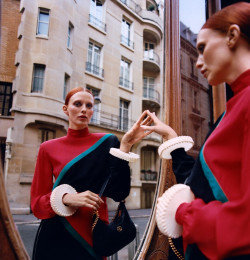
Latest Catalogues from Gucci
